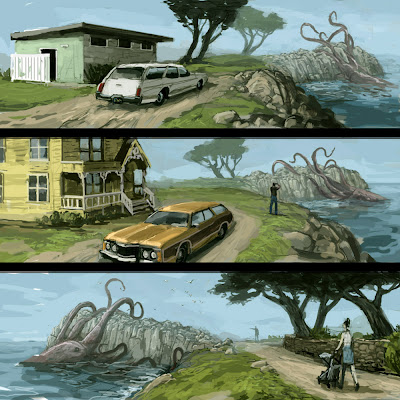Post all of this stuff by Monday, February 10:
1. Do 20 thumbnails of environment ideas. See above. Keep it loose and flowing. Don't spend too much time on any one thumbnail. The point is to practice getting an idea down in a pure form without being distracted by detail. Stay loose and discover while you draw. You don't need to know what you're drawing before you draw it. Your approach may end up having similarities to your silhouette work. Thin about foreground, mid-ground, background, areas of interest/focus, dark/light, and scale contrast. You may or may not want to be thinking about what medium you're drawing for (game, movie, animation, film, theater, etc)... or you may not. This is a very primal stage in the creative process, so you don't have to be worried about this... yet... And, yes, print these. Blow 'em up so they're easy to see, if you work small.
2. Go to a location you've never been to before and write about the experience. How did you choose the spot? Why? Describe the sensations, what you noticed, how you felt being there. Describe the place physically, the quality of light, the color, sounds, sights, time of day, etc. What made this place a place? Print this out, so you can share it in class.
3. Collect reference photos for some extended concepts that you can build off of your thumbnails. These references might give you specific details on architecture, lighting, composition, foliage, fauna, urban clutter, tapestries, pastries, patisseries, whatever information you need to flesh out your imaginary world.
Here's where we're going with this stuff eventually...
Preproduction concepts from Fallout 3 by Craig Mullins. A masterly example of collage/painting hybrid approach.
Alex Munn's work is more "painterly" but shows clear use of observed visual reference in the specific car models and architectural styles.
A few of Bill Wray's knockout backgrounds for the 2D animated show, Samurai Jack













Ashley Reid's Blog http://ashleyre1d.tumblr.com/
ReplyDelete